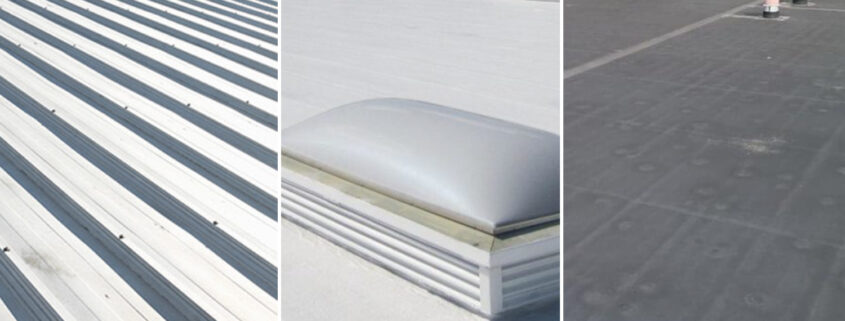Your commercial building is an important asset – so make sure it’s taken care of (and protected).
One sure fire way to keep your building protected and your business operational, is to use the best of the best when it comes to your roofing materials. There are several common commercial roof types on the market – but, how do you know which one is right for your commercial property?
Most Common Type of Commercial Roofing Systems
Pitched roofs with steep slopes are the norm for residential roofing, and typically have asphalt shingle roofs. Flat roofs, also known as low-slope roofs, tend to be the most popular type of roofing system for commercial properties. Flat roofs are a more popular option for business owners and industrial roofs because they can cover larger buildings and support large HVAC systems.
Rating the Types of Commercial Roofing Materials
Flat roofs use different types of roofing materials (compared to pitched roofs) which vary in lifespan, energy efficiency and installation cost. The following are the most common types of roofing materials used for commercial flat roofs, including a comparison of how they stack up against each other.
Built-Up Roofing (BUR)
BUR roofs are made by layering asphalt and ply sheets over the roof deck. BUR roofing has been around since the late 1800s and was the first flat roof material on the market.
It’s been around for so long for good reason. It’s fire resistant while protecting from ultraviolet rays (making it a great option for hot, sunny climates). However, these materials are more vulnerable to damage from freeze-and-thaw cycles, water pooling and high winds.
All that said, they’re cost-effective to install, and with the right care and climate, can be expected to last 20-40 years.
Modified Bitumen Roofing
Modified bitumen is similar in installation and material to BUR roofs. This material is made by layering asphalt or rubber with fiberglass or polyester fabric. BUR and Modified Bitumen have similar installation costs, as well. Like BUR, Modified Bitumen is UV resistant and works well in hot climates.
But – like BUR – modified bitumen roofing is not always the best option for cold climates, and it can be more susceptible to damage from standing water as compared to other roofing materials. Typically, its lifespan is anywhere from 20-30 years.
Polyvinyl Chloride (PVC) Roofing
If you’re looking for an eco-friendly, green roof, PVC roofing is a good option. The energy efficiency of this single-ply membrane will save you money on your heating and cooling costs.
Like BUR roofs, PVC is a fire-resistant roofing material and resistant to wear and tear from high winds. However, it can be vulnerable to shattering and cracking in cold temperatures.
Typically, PVC roofing costs a little more than BUR. Its lifespan is comparable, though. PVC roofs regularly last 20 – 30 years.
Thermoplastic Polyolefin (TPO) Roofing
TPO roofing is one of the most cost-effective roofing membranes when it comes to installation, and it can help you cut down on energy costs. In fact, it’s the most energy-efficient of the common commercial roofing materials. This single-ply roofing membrane is one of the newest on the market, but it has rapidly become a popular option thanks to its cost.
TPO’s average lifespan is on the shorter side of things, however. This roof material typically lasts around 20 years. Unlike BUR and PVC, TPO isn’t great for hot climates and can shrink if regularly overheated. It’s also more prone to puncturing.
Ethylene Propylene Diene Monomer (EPDM) Roofing
EPDM roofing, also known as thermoset roofing, is a rubber roofing option that is a durable, lower-cost option. EPDM roofing membranes are energy efficient in the winter, but tend to absorb UV rays in summer months. When it comes to cold weather conditions, this is one of the best options overall.
This roofing material has synthetic rubber seams that can have problems being water-resistant. Without proper maintenance, they can foster moisture, allowing for mold and mildew build-up (that’s why regular maintenance and cleaning are required). With the proper care, however, you can expect EPDM roofing to last from 20-35 years.
Metal Roofing
Metal roofing systems are on the more expensive side, and for good reason. They’re one of the longest-lasting commercial roofing options. With proper care, building owners can expect metal roofs to last 50 years or longer.
They’re fire-resistant, they cool quickly once the sun is down, and they withstand severe weather conditions. Overall, when it comes to durability no matter where you live, a metal roofing system is your best bet.
Getting the Most Out of Your Commercial Roofing Materials
No matter what roofing solution you go with for your new roof, it’s important to take proper care of it to avoid a costly roof repair. Regular inspections and maintenance greatly extend your roof’s lifespan, no matter the material.
It’s important to also make sure that the installation is done properly. Commercial roofers who cut corners during installation are also cutting years off of your new roof’s lifespan. That’s why it’s important to hire reputable and reliable commercial roofing contractors for your roofing projects.
Reliable Roofing Contractors = Reliable Roofing Systems
TEMA has over 50 years of experience in providing a full range of quality roofing services. From overseeing the installation of solar panels and installing every different type of commercial roofing system to providing emergency roof repair services, we offer everything needed to keep your commercial property covered (and protected for years and years to come).
If you’re looking for more help picking between the common commercial roof types and getting your roofing materials installed, contact us! We’re ready to discuss your commercial property’s roofing needs and help settle upon the best roof material for your budget.





